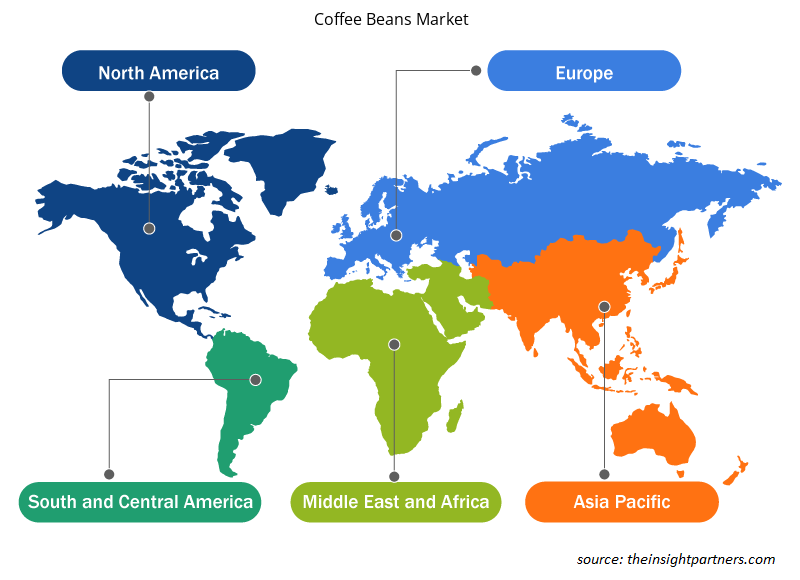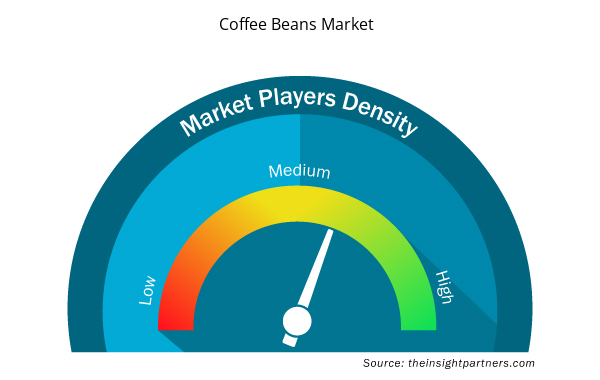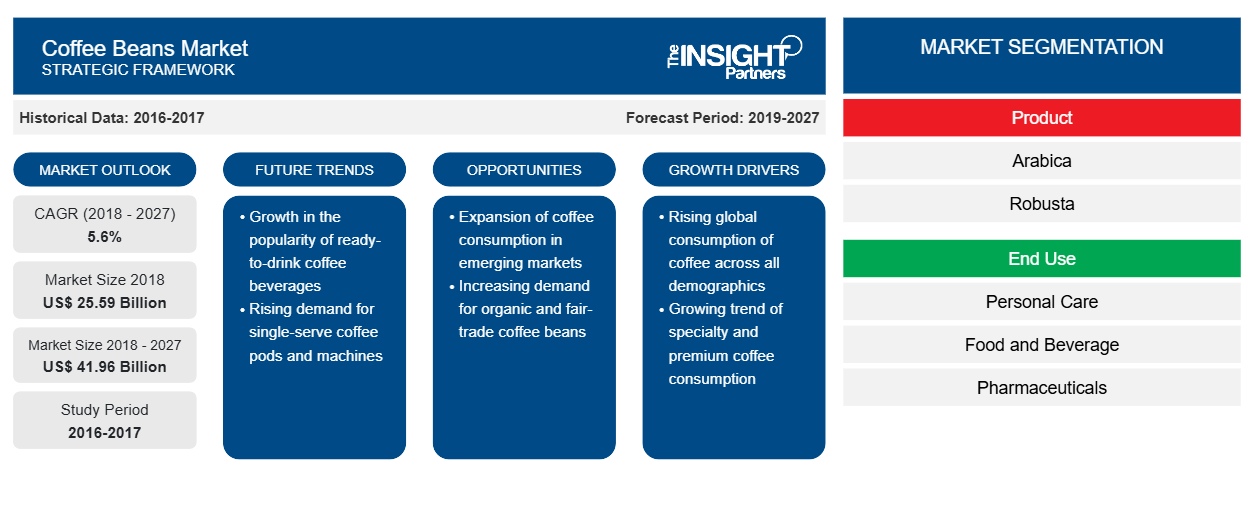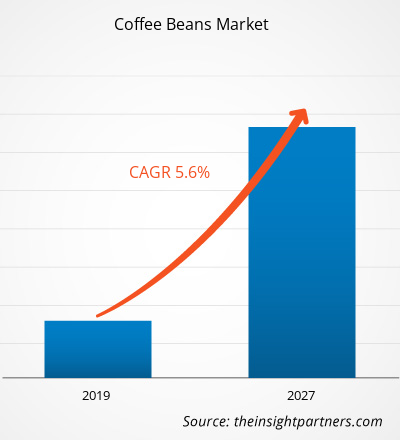[研究报告] 2018 年咖啡豆市场价值为 255.917 亿美元,预计到 2027 年将达到 419.624 亿美元;预计 2019 年至 2027 年的复合年增长率为 5.6%。
咖啡豆是咖啡树结出的种子,咖啡树是咖啡的丰富来源。咖啡豆并不完全是豆子,但它们被称为咖啡豆,因为它们的外观与真正的豆子相似。就像普通的樱桃一样,咖啡豆也是一种所谓的核果。咖啡树的两个最重要的品种是阿拉比卡咖啡和罗布斯塔咖啡。根据一些研究,咖啡树最早是由一位名叫卡尔迪的牧羊人在埃塞俄比亚发现的。咖啡豆是一种主要的经济作物,也是出口的重要产品。根据产品,咖啡豆市场分为阿拉比卡咖啡、罗布斯塔咖啡和其他咖啡。2018 年,阿拉比卡咖啡占据了主要市场份额,占据了主导地位。阿拉比卡咖啡树生产出优质芳香的咖啡。与罗布斯塔咖啡相比,阿拉比卡咖啡的豆子扁平细长,咖啡因含量较低。阿拉比卡咖啡豆热量低,含有丰富的矿物质,如烟酸、钾和锰。高品质的阿拉比卡咖啡带有淡淡的甜味,并带有巧克力、坚果和焦糖的味道,甚至可能带有一点苦味和微酸。
预计亚太地区在预测期内的复合年增长率最高,为 6.0%。由于不同咖啡产品在该地区消费者中越来越受欢迎,预计亚太地区将在全球咖啡豆市场中获得相当大的份额。印度、泰国、菲律宾和印度尼西亚等国家的咖啡馆和咖啡店数量正在增加,这进一步促进了咖啡豆市场的发展。东南亚的气候和地理位置非常适合种植咖啡。此外,该地区的咖啡文化和咖啡生产专业知识促进了该地区咖啡产业的蓬勃发展。一些东南亚国家已成为咖啡出口巨头,包括印度尼西亚、越南和老挝。泰国也因其不断增长的咖啡需求而吸引了企业和投资。此外,菲律宾决心振兴其咖啡产业,以瞄准利基市场和日益增长的国内特色咖啡需求。在目前的情况下,越南是继巴西之后全球第二大咖啡出口国。 2017年,咖啡总产量为29,500,000袋(每袋60公斤),其次是印度尼西亚,总产量为10,902,000袋。
COVID-19 对咖啡豆市场的影响
COVID-19 疫情于 2019 年 12 月首先在中国武汉爆发,此后迅速蔓延至全球。截至 2020 年 3 月,中国、意大利、伊朗、印度、俄罗斯、西班牙、韩国、法国、德国和美国是确诊病例和死亡人数最多的国家。根据世界卫生组织的最新数据,全球确诊病例约 9,843,073 例,死亡人数 495,760 例。由于封锁、旅行禁令和企业停工,COVID-19 疫情已影响到各国的经济和行业。全球食品加工行业是受疫情影响最大的行业之一,工厂关闭、供应链中断、技术活动取消、办公室关闭等都给疫情造成了严重影响。
定制此报告以满足您的需求
您可以免费定制任何报告,包括本报告的部分内容、国家级分析、Excel 数据包,以及为初创企业和大学提供优惠和折扣
- 获取此报告的关键市场趋势。这个免费样品将包括数据分析,从市场趋势到估计和预测。
市场洞察
咖啡和咖啡饮料消费量增加
咖啡是全球消费量最大的饮料之一。咖啡在年轻人中越来越受欢迎,尤其是在印度、中国和菲律宾等国家,这刺激了对咖啡豆的需求。咖啡消费有几个主要动机,例如功能、口味和愉悦感、习惯、传统、文化和社交。中产阶级人口的增加和整体生活水平的提高,导致对咖啡和咖啡饮料的需求增加。办公室专业人士的咖啡消费量也大幅增长。当地咖啡店和新咖啡店的开业和扩张是推动咖啡需求的另一个因素,这反过来又促进了咖啡豆市场的增长。此外,牛奶消费量的增加有利于市场增长,因为消费者将咖啡混入牛奶中以改善口感。在咖啡馆逗留和长时间停留的机会也吸引了消费者的注意,这反过来又增加了对咖啡的需求。除此之外,咖啡馆还是图书馆的替代品。此外,年轻人认为喝咖啡是一种时尚和轻松的生活方式,这反过来又导致咖啡需求激增。咖啡豆经过不同的处理,以各种类型的咖啡混合物出售,并在零售店、杂货店和网上都有销售。
产品洞察
根据产品,咖啡豆市场细分为阿拉比卡咖啡、罗布斯塔咖啡和其他。2018 年,阿拉比卡咖啡占全球咖啡豆市场的最大份额,而罗布斯塔咖啡预计在预测期内将以更高的复合年增长率增长。阿拉比卡咖啡是最古老、最主要的咖啡品种。它来自阿拉比卡咖啡灌木,也被称为山地咖啡或阿拉比卡咖啡。阿拉比卡咖啡占世界咖啡产量和消费量的近 60%。阿拉比卡咖啡豆原产于埃塞俄比亚、南苏丹和也门,自 12 世纪以来就开始在那里种植和栽培。目前,它们遍布全球,从非洲到拉丁美洲,从亚洲到加勒比地区。阿拉比卡咖啡是树木或大灌木,开着白色的花,结着鲜红色的浆果。每颗浆果都含有两颗种子,最终会变成咖啡豆。阿拉比卡咖啡大约需要七年才能完全成熟并结出果实。此外,在这七年里,咖啡不能收获。与罗布斯塔咖啡相比,阿拉比卡咖啡的脂质含量高出 60%,糖分浓度是罗布斯塔咖啡的两倍。阿拉比卡咖啡可以耐受低温,在平均温度 15 至 24 度时生长最佳。一种阿拉比卡咖啡含有有限量的咖啡因。阿拉比卡咖啡富含抗氧化剂,含有少量维生素和矿物质,如烟酸、镁、锰和钾。优质的阿拉比卡咖啡味道微甜,带有坚果、焦糖和巧克力的味道。路易达孚公司、Bharat Company Depot 等公司都提供阿拉比卡咖啡豆。
最终用途洞察
根据最终用途,咖啡豆市场细分为食品和饮料、个人护理和药品。2018 年,食品和饮料部门在全球咖啡豆市场中占最大份额,预计在预测期内将实现最快的增长率。咖啡是商业化食品之一,也是全球消费最广泛的饮料。咖啡消费量增加的原因包括通过选择不同品种来提高咖啡质量、改进农业实践和开设专卖店。咖啡豆用于不同种类的食物,因为它们富含抗氧化剂,可降低患糖尿病的风险并对抗炎症。咖啡摩卡饼干、咖啡糖饼干、咖啡擦牛排、咖啡巧克力布朗尼和咖啡擦脆皮烤猪肉等食品都是用咖啡或咖啡豆制成的。在咖啡摩卡饼干中使用咖啡豆不仅可以带来美味的咖啡味,还可以增加浓郁的巧克力味。咖啡糖饼干提供甜味和浓郁的咖啡味。布朗尼蛋糕的奢华甜品搭配顺滑的咖啡风味,为咖啡带来令人垂涎的味道。世界各地的咖啡饮料以各种风格和风格制作和呈现,但它们的制作方法和所用原料不同。特浓咖啡、特浓玛奇朵和卡布奇诺是大多数人饮用的一些咖啡饮料。
公司通常采用并购和研发来扩大其全球影响力,这进一步影响了市场规模。咖啡豆市场的参与者,如 Illycafe SpA 和 Peets Coffee,一直在实施并购和研发战略,以扩大客户群并在全球范围内获得显著的市场份额,这也使参与者能够在全球范围内保持其品牌名称。例如,2019 年 8 月,Illycafe SpA 宣布从 Euro Food Brands (EFB Group) 收购其英国分销业务。Euro Food Brands 仅负责 Illy 产品在英国的分销。此举旨在雇用更多员工来管理和发展公司。
咖啡豆市场区域洞察
Insight Partners 的分析师已详尽解释了预测期内影响咖啡豆市场的区域趋势和因素。本节还讨论了北美、欧洲、亚太地区、中东和非洲以及南美和中美洲的咖啡豆市场细分和地理位置。

- 获取咖啡豆市场的区域特定数据
咖啡豆市场报告范围
| 报告属性 | 细节 |
|---|---|
| 2018 年市场规模 | 255.9亿美元 |
| 2027 年市场规模 | 419.6亿美元 |
| 全球复合年增长率(2018 - 2027) | 5.6% |
| 史料 | 2016-2017 |
| 预测期 | 2019-2027 |
| 涵盖的领域 | 按产品
|
| 覆盖地区和国家 | 北美
|
| 市场领导者和主要公司简介 |
|
市场参与者密度:了解其对商业动态的影响
咖啡豆市场正在快速增长,这得益于终端用户需求的不断增长,而这些需求又源于消费者偏好的不断变化、技术进步以及对产品优势的认识不断提高等因素。随着需求的增加,企业正在扩大其产品范围,进行创新以满足消费者的需求,并利用新兴趋势,从而进一步推动市场增长。
市场参与者密度是指在特定市场或行业内运营的企业或公司的分布情况。它表明相对于给定市场空间的规模或总市场价值,有多少竞争对手(市场参与者)存在于该市场空间中。
在咖啡豆市场运营的主要公司有:
- 印度咖啡仓库
- 死亡愿望咖啡公司
- 黄金咖啡公司
- 夏威夷群岛科纳咖啡有限公司
- 踢马全豆
免责声明:上面列出的公司没有按照任何特定顺序排列。

- 获取咖啡豆市场顶级关键参与者概述
全球咖啡豆市场 – 按产品分类
- 阿拉比卡咖啡
- 罗布斯塔
- 其他的
全球咖啡豆市场 – 按最终用途划分
- 食品和饮料
- 个人护理
- 药品
公司简介
- 印度咖啡仓库
- 死亡愿望咖啡公司
- 黄金咖啡公司
- 夏威夷群岛科纳咖啡有限公司
- Kicking Horse Whole Beans 公司
- Illycafe SpA 公司
- 咖啡豆公司
- Peets 咖啡和茶股份有限公司
- 星巴克咖啡公司
- 直接咖啡有限公司
- 历史分析(2 年)、基准年、预测(7 年)及复合年增长率
- PEST 和 SWOT 分析
- 市场规模价值/数量 - 全球、区域、国家
- 行业和竞争格局
- Excel 数据集



Report Coverage
Revenue forecast, Company Analysis, Industry landscape, Growth factors, and Trends

Segment Covered
This text is related
to segments covered.

Regional Scope
North America, Europe, Asia Pacific, Middle East & Africa, South & Central America

Country Scope
This text is related
to country scope.
Trends and growth analysis reports related to Food and Beverages : READ MORE..
The List of Companies - Coffee Beans Market
- Bharat Coffee Depot
- Death Wish Coffee Company
- Gold Coffee Company
- Hawaiian Isles Kona Coffee Company, Ltd
- Kicking Horse Whole Beans
- IllycaffS.p.A Company
- The Coffee Beans Co
- Peets Coffee
- Starbucks Coffee Company
- Direct Coffee GmbH
The Insight Partners performs research in 4 major stages: Data Collection & Secondary Research, Primary Research, Data Analysis and Data Triangulation & Final Review.
- Data Collection and Secondary Research:
As a market research and consulting firm operating from a decade, we have published and advised several client across the globe. First step for any study will start with an assessment of currently available data and insights from existing reports. Further, historical and current market information is collected from Investor Presentations, Annual Reports, SEC Filings, etc., and other information related to company’s performance and market positioning are gathered from Paid Databases (Factiva, Hoovers, and Reuters) and various other publications available in public domain.
Several associations trade associates, technical forums, institutes, societies and organization are accessed to gain technical as well as market related insights through their publications such as research papers, blogs and press releases related to the studies are referred to get cues about the market. Further, white papers, journals, magazines, and other news articles published in last 3 years are scrutinized and analyzed to understand the current market trends.
- Primary Research:
The primarily interview analysis comprise of data obtained from industry participants interview and answers to survey questions gathered by in-house primary team.
For primary research, interviews are conducted with industry experts/CEOs/Marketing Managers/VPs/Subject Matter Experts from both demand and supply side to get a 360-degree view of the market. The primary team conducts several interviews based on the complexity of the markets to understand the various market trends and dynamics which makes research more credible and precise.
A typical research interview fulfils the following functions:
- Provides first-hand information on the market size, market trends, growth trends, competitive landscape, and outlook
- Validates and strengthens in-house secondary research findings
- Develops the analysis team’s expertise and market understanding
Primary research involves email interactions and telephone interviews for each market, category, segment, and sub-segment across geographies. The participants who typically take part in such a process include, but are not limited to:
- Industry participants: VPs, business development managers, market intelligence managers and national sales managers
- Outside experts: Valuation experts, research analysts and key opinion leaders specializing in the electronics and semiconductor industry.
Below is the breakup of our primary respondents by company, designation, and region:

Once we receive the confirmation from primary research sources or primary respondents, we finalize the base year market estimation and forecast the data as per the macroeconomic and microeconomic factors assessed during data collection.
- Data Analysis:
Once data is validated through both secondary as well as primary respondents, we finalize the market estimations by hypothesis formulation and factor analysis at regional and country level.
- Macro-Economic Factor Analysis:
We analyse macroeconomic indicators such the gross domestic product (GDP), increase in the demand for goods and services across industries, technological advancement, regional economic growth, governmental policies, the influence of COVID-19, PEST analysis, and other aspects. This analysis aids in setting benchmarks for various nations/regions and approximating market splits. Additionally, the general trend of the aforementioned components aid in determining the market's development possibilities.
- Country Level Data:
Various factors that are especially aligned to the country are taken into account to determine the market size for a certain area and country, including the presence of vendors, such as headquarters and offices, the country's GDP, demand patterns, and industry growth. To comprehend the market dynamics for the nation, a number of growth variables, inhibitors, application areas, and current market trends are researched. The aforementioned elements aid in determining the country's overall market's growth potential.
- Company Profile:
The “Table of Contents” is formulated by listing and analyzing more than 25 - 30 companies operating in the market ecosystem across geographies. However, we profile only 10 companies as a standard practice in our syndicate reports. These 10 companies comprise leading, emerging, and regional players. Nonetheless, our analysis is not restricted to the 10 listed companies, we also analyze other companies present in the market to develop a holistic view and understand the prevailing trends. The “Company Profiles” section in the report covers key facts, business description, products & services, financial information, SWOT analysis, and key developments. The financial information presented is extracted from the annual reports and official documents of the publicly listed companies. Upon collecting the information for the sections of respective companies, we verify them via various primary sources and then compile the data in respective company profiles. The company level information helps us in deriving the base number as well as in forecasting the market size.
- Developing Base Number:
Aggregation of sales statistics (2020-2022) and macro-economic factor, and other secondary and primary research insights are utilized to arrive at base number and related market shares for 2022. The data gaps are identified in this step and relevant market data is analyzed, collected from paid primary interviews or databases. On finalizing the base year market size, forecasts are developed on the basis of macro-economic, industry and market growth factors and company level analysis.
- Data Triangulation and Final Review:
The market findings and base year market size calculations are validated from supply as well as demand side. Demand side validations are based on macro-economic factor analysis and benchmarks for respective regions and countries. In case of supply side validations, revenues of major companies are estimated (in case not available) based on industry benchmark, approximate number of employees, product portfolio, and primary interviews revenues are gathered. Further revenue from target product/service segment is assessed to avoid overshooting of market statistics. In case of heavy deviations between supply and demand side values, all thes steps are repeated to achieve synchronization.
We follow an iterative model, wherein we share our research findings with Subject Matter Experts (SME’s) and Key Opinion Leaders (KOLs) until consensus view of the market is not formulated – this model negates any drastic deviation in the opinions of experts. Only validated and universally acceptable research findings are quoted in our reports.
We have important check points that we use to validate our research findings – which we call – data triangulation, where we validate the information, we generate from secondary sources with primary interviews and then we re-validate with our internal data bases and Subject matter experts. This comprehensive model enables us to deliver high quality, reliable data in shortest possible time.


 获取此报告的免费样本
获取此报告的免费样本